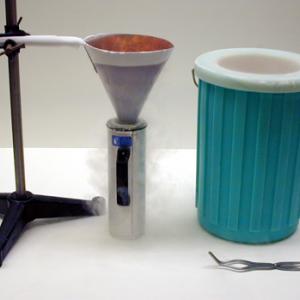College of Liberal Arts & Sciences
4C30.80 - Liquid Nitrogen - Making Liquid O2 & Liquid Argon
NOTE: The equipment for this demonstration can be found on the 4A40.70 shelf. This equipment is also used for the 4A40.70 and 5G30.20 demonstrations.
Pour liquid nitrogen in the small dewar to cool it to the proper temperature. When the boiling ceases, pour all the liquid nitrogen from the dewar into the copper funnel. Place the dewar under the point of the copper funnel to collect the liquid oxygen. You should be able to collect 50 to 100 ml in a 20 minute time frame.
To make liquid Argon from the Argon gas cylinder you need to connect a small hose to the special test tube as shown. Put a 12 or 14 inch balloon onto the top of the test tube. Carefully open the gas cylinder and inflate the test tube/balloon apparatus with Argon until the balloon is good sized. Pour some liquid nitrogen into a small dewar and insert the test tube/balloon system into the liquid nitrogen. As the Argon condenses in the test tube, the balloon will shrink in size. Re-inflate with Argon gas as necessary until the desired amount of liquid Argon is collected.
- Thomas K. McCarthy, "Two Cryogenic Demonstrations", TPT, Vol. 29, # 9, Dec. 1991, p. 575.
Disclaimer: These demonstrations are provided only for illustrative use by persons affiliated with The University of Iowa and only under the direction of a trained instructor or physicist. The University of Iowa is not responsible for demonstrations performed by those using their own equipment or who choose to use this reference material for their own purpose. The demonstrations included here are within the public domain and can be found in materials contained in libraries, bookstores, and through electronic sources. Performing all or any portion of any of these demonstrations, with or without revisions not depicted here entails inherent risks. These risks include, without limitation, bodily injury (and possibly death), including risks to health that may be temporary or permanent and that may exacerbate a pre-existing medical condition; and property loss or damage. Anyone performing any part of these demonstrations, even with revisions, knowingly and voluntarily assumes all risks associated with them.
